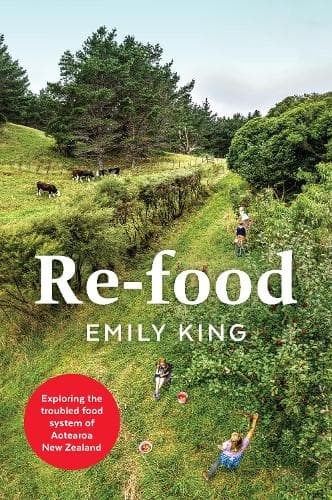Review: Re-food: Exploring the troubled food system of Aotearoa New Zealand
Reviewed by Lauraine Jacobs
There’s no doubt, especially in a time where so many struggle to feed the family and we recognise the food insecurity lurking in our society, that Aotearoa New Zealand needs to reset the collective thinking around food: what we grow and produce, how we distribute food and how we eat. The Māori whakatauāki (proverb) “Nau te rourou, naku te rourou, ka ora te manuhiri” – my food basket, your food basket, the people will thrive - expresses this clearly.
Well-intentioned organisations, volunteers and companies too are aware of food struggles and while many accomplish good things, it is going to take a major collective shift by everybody from government through to individual members of our society to achieve the turnaround necessary to take us successfully into a future where everyone is well nourished and ethical food producers reap the rewards of their hard work.
Emily King, an environmental lawyer turned advocate, has worked locally and at high levels around the world, researching, assisting and addressing these challenges. Her ground-breaking book Re-food sets out solutions clearly. It is a book for everyone, one that the author has thoughtfully and gently written in a way that makes it simple to understand the inherent problems in resetting a nation’s thinking, while offering ideas for individual to follow to kick off changes at a very practical level. Even the glossary at the back of the book is filled with words and phrases that everybody should ponder and become familiar with.
King divides her book in three sections, Grow, Make and Nourish. Grow delves into how food is produced, examining the importance of soil and regeneration, farming practices and approaches, the use and vitality of water, and (the ‘biggie’)climate change along with their impact on the whole food system. This section makes for alarming reading at times but as King points out, all of us must go through a degree of discomfort to effect the changes necessary. One idea that really resonates is ‘...it’s easy to point blame at farmers, but blame doesn’t help anyone or solve our environmental or social issues… We need to drink a big cup of empathy and stitch back together our rural/urban divide.’ We should all take time to understand and make connections with farmers and those who produce our food.
The book’s second section, Make, must have been to most difficult to write. King ‘unpacks’ (a word she uses often) overpackaging and food waste and exposes some alarming practises. We think we’re aware of the overuse of plastic and the damage it is doing to the planet - and King’s ideas on rethinking convenience, shopping and eating are not revolutionary - but all are reminders of how to correct this. Her reveal that ‘approximately 12 per cent of all household food purchased in Aotearoa New Zealand goes to waste, amounting to an estimated $1.17billion’ is more than enough to shock every reader into altering their daily food routines.
Nourish, the third section of King’s book, puts a strong case for change for the future. But it is not all doom and gloom, as she examines the keys to finding good food, identifying the gaps and shortfalls of our present system, and suggesting possible paths forward to provide answers.
Re-food doesn’t examine or dwell on kaimoana, and although that omission is acknowledged by the author, I felt the book would have been improved with understanding the importance and possibilities of the ocean and its bounty to Aotearoa New Zealand food systems. It is a vital part of feeding us.
The supermarket network comes in for valid criticism while King certainly is clear on suggestions for how to eat well and those foods that fail to contribute to improved nutrition. Her extensive research and interviews with some of the leaders in the health and nutrition sector show that food should be integrated into our economics and health systems (sugar tax anyone?) as she recommends, ‘we need bold leadership from people in both the food industry and the Government to change these practices.’
Each chapter concludes with a break-out box ‘How To Re-food’ offering a summary in bullet points of practical solutions for the reader to think about and apply to daily life. If readers take on even just a few of these points we may reach this better future more quickly, but nothing could be as good as this book being required reading for every thinking person and, of course, for elected officials of government, both local and national.
Reviewed by Lauraine Jacobs
